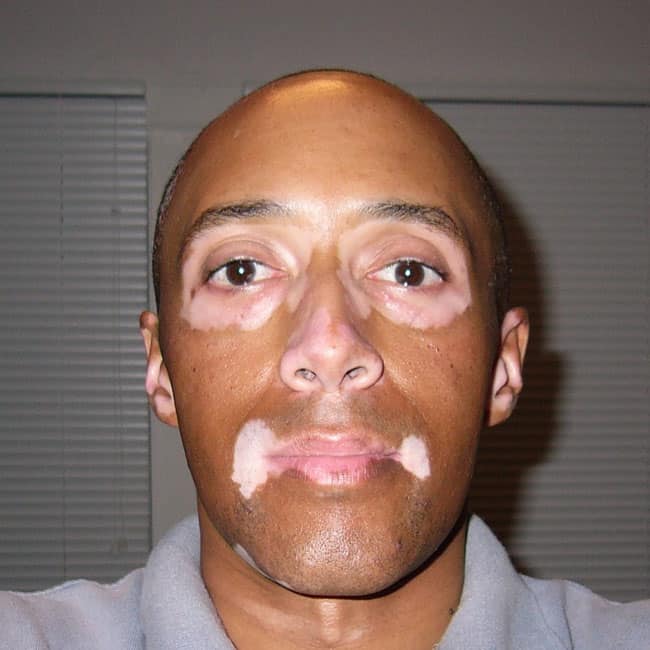Vitiligo Dermatologists in Southampton, PA
What is Vitiligo?
Vitiligo is a chronic skin condition characterized by the loss of melanocytes. Melanocytes are specialized cells in the skin that produce melanin, a protective skin darkening pigment. It manifests as growing patches of skin depigmentation, sometimes with flecks of remaining pigment. Some patients with vitiligo also develop white patches of hair. Vitiligo affects people of all skin types but is most visible on people with darker baseline skin. While Vitiligo is not a fatal condition, it does cause significant psychosocial distress and discomfort to patients afflicted by it.
The color of the skin and hair is usually dependent on the pigment called melanin. Vitiligo occurs when the cells responsible for producing melanin die or stop functioning. This condition can, therefore, affect the skin, hair, oral mucosa and even the eyes. In most cases, the discolored areas may persist throughout life. It affects about 1-2% of the population, and is oftentimes associated with other autoimmune conditions like thyroid dysfunction, anemia, and diabetes.

JAMA Dermatology

TYPES OF VITILIGO
This classification is based on the region of the body where it is found. Non-segmental Vitiligo is the most common type and affects bilaterally symmetric areas. The progression is relatively slow compared to the segmental type. They frequently appear on portions of skin exposed to sunlight and trauma such as the neck, face, chest, feet, hands etc. It has no specific area or size and each patient’s vitiligo behaves and affects different areas than others. It could also be acrofacial (involving the face, hands and feet) and focal (characterized by many white spots concentrated in a particular area). Confetti-like Vitiligo refers to flecks of depigmentation that eventually becomes classic Non-segmental vitiligo.
Segmental Vitiligo, on the other hand, is a far less common type. It spreads more rapidly than non-segmental Vitiligo and involves a patch of skin on only one side of the body.
SIGNS AND SYMPTOMS OF VITILIGO
CAUSES OF VITILIGO
"Phototherapy is the most effective method of treating vitiligo. It often requires long treatment durations over several months but the majority of patients respond to it..."
VITILIGO TREATMENT AND MANAGEMENT in Southampton, PA
There is no cure for Vitiligo although numerous treatments exist with the aim of restoring the patient’s original skin color. Some of the methods include:
Camouflage therapy:
Vitiligo patients should use sunscreen to avoid normal skin tanning and making the vitiligo more obvious. The recommended sunscreens are those with SPF of 30 or higher. The sunscreen should be able to protect against the effect of Ultraviolet A and B rays.
Another commonly used camouflage method is the use of makeup, which helps to mimic a uniform skin tone. Dermabland and Covermark are two examples of oil based concealer makeups. Hair dyes can also be used if hair is affected.
Repigmentation Therapy:
Corticosteroids are used topically, as well as steroid sparing medications such as tacrolimus. The goal is to suppress the body’s immune reaction against the pigment producing cells and increase their growth and pigment production. Results may be slow and can take up to 3 months. Side effects, such as skin thinning and stretch marks, may occur; however, they are uncommon with proper use as directed by your Pennsylvania Dermatology Specialists provider.
Contact Our Dermatologists in Southampton PA Today
You don’t have to feel distressed. Call our office to find relief from vitiligo.
The Best Dermatologist and Dermatology Providers for Vitiligo in Southampton PA
One of the most mysterious skin conditions that exist today is vitiligo. If you suffer from vitiligo, then you know immediately. Patches of your skin can turn mysteriously white. It occurs when certain cells responsible for skin color die. Scientists don’t know yet why these cells die. For many people, vitiligo can be a distressing situation. You may feel embarrassed about the patches of different colored skin. Luckily, treatment is possible. At Penn Dermatology Specialists, we have a professional dermatologist and dermatology providers for vitiligo who are ready to help. Here’s what you need to know about our treatment for vitiligo.
You Can Rely on Our Dermatologist and Dermatology Providers for Vitiligo in Southampton, PA
Diagnosing and treating vitiligo can be difficult for inexperienced dermatologists. The diagnosing part is easy. Vitiligo can cause different pigmentation in the following places:
- Skin
- Hair
- Mouth
- Eyes
- Genitals
If you notice a stark change in color in any of these areas, then you need our dermatologist and dermatology providers for vitiligo. Diagnosis will involve a thorough search of the affected area to determine if it’s due to vitiligo or another cause. After the examination, our dermatologists for vitiligo can suggest a treatment option.
The best treatment for this skin condition is phototherapy in Southampton PA. Phototherapy involves pulsing bright lights into affected areas. It injures cells. As a result, the immune system kicks into overdrive and repairs these cells. They may also create new ones.
The new cells bring their pigment to the affected area, returning it to its normal color. Light therapy in Southampton PA is safe and easy. It’s a minimally invasive treatment which means it takes less of a recovery period.

PHOTOTHERAPY FOR VITILIGO
Phototherapy is the most effective method of treating vitiligo. It often requires long treatment durations over several months but the majority of patients respond to it and can often get a large quantity of their pigment back, particularly on the face. Treatments are quick and convenient, usually done 2-3x per week. Phototherapy also improves the action of topical medications on vitiligo.
NBUVB (Narrowband UVB) is the most commonly used phototherapy for vitiligo, and Pennsylvania Dermatology Specialists is proud to offer it for our vitiligo patients. It does not increase the risk of skin cancer and achieves great improvement in vitiligo. Our phototherapy box is top of the line, featuring safety features and automated dosimetry .




